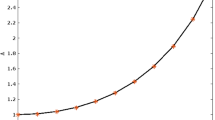Abstract
The state-of-the-art, large-scale numerical simulations of the scattering problem for the Helmholtz equation in two dimensions rely on iterative solvers for the Lippmann–Schwinger integral equation, with an optimal CPU time O(m 3 log (m)) for an m-by-m wavelength problem. We present a method to solve the same problem directly, as opposed to iteratively, with the obvious advantage in efficiency for multiple right-hand sides corresponding to distinct incident waves. Analytically, this direct method is a hierarchical, recursive scheme consisting of the so-called splitting and merging processes. Algebraically, it amounts to a recursive matrix decomposition, for a cost of O(m 3), of the discretized Lippmann–Schwinger operator. With this matrix decomposition, each back substitution requires only O(m 2 log (m)); therefore, a scattering problem with m incident waves can be solved, altogether, in O(m 3 log (m)) flops.
Similar content being viewed by others
References
Y.H. Chen, W.C. Chew and S. Zeroug, Fast multipole method as an efficient solver for 2D elastic wave surface integral equations, Comput. Mech. 20(6) (1997) 495-506.
W. Chew and C. Lu, The use of the Huygens' equivalence principle for solving the volume integral equations of scattering, IEEE Antennas Propag. 41(7) (1993) 897-904.
L. Greengard, J. Huang, S. Wandzura and V. Rokhlin, Accelerating fast multipole methods for low frequency scattering, IEEE Comput. Sci. Engrg. 5(3) (1998).
P. Jones, J. Ma and V. Rokhlin, A fast direct algorithm for the solution of the Laplace equation on regions with fractal boundaries, J. Comput. Phys. 113(1) (1994).
J.H. Lin and W.C. Chew, Solution of the three-dimensional electromagnetic inverse problem by the local shape function and the conjugate gradient fast Fourier transform methods, J. Opt. Soc. Amer. 14(11) (1997) 3037-3045.
C. Lu and W. Chew, The use of the Huygens' equivalence principle for solving 3D volume integral equations of scattering, IEEE Antennas Propag. 43(5) (1995) 500-507.
J.M. Song, C.C. Lu, W.C. Chew et al., Fast Illinois Solver Code (FISC), IEEE Antennas Propag. 40(3) (1998) 27-34.
W.W. Symes, Iterative procedures for wave propagation in the frequency domain, Technical Reports, Rice University (1996).
J.S. Zhao and W.C. Chew, Three-dimensional multilevel fast multipole algorithm from static to electrodynamic, Microw. Opt. Techn. Lett. 26(1) (2000) 43-48.
Author information
Authors and Affiliations
Rights and permissions
About this article
Cite this article
Chen, Y. A Fast, Direct Algorithm for the Lippmann–Schwinger Integral Equation in Two Dimensions. Advances in Computational Mathematics 16, 175–190 (2002). https://doi.org/10.1023/A:1014450116300
Issue Date:
DOI: https://doi.org/10.1023/A:1014450116300




